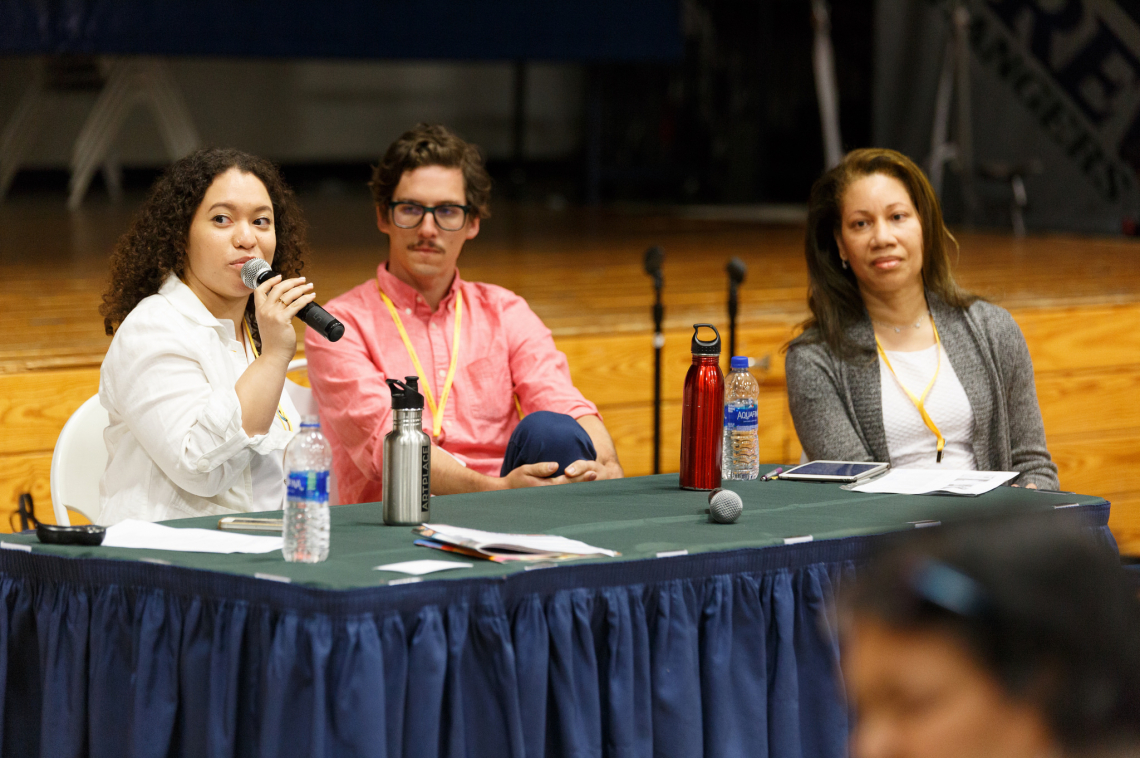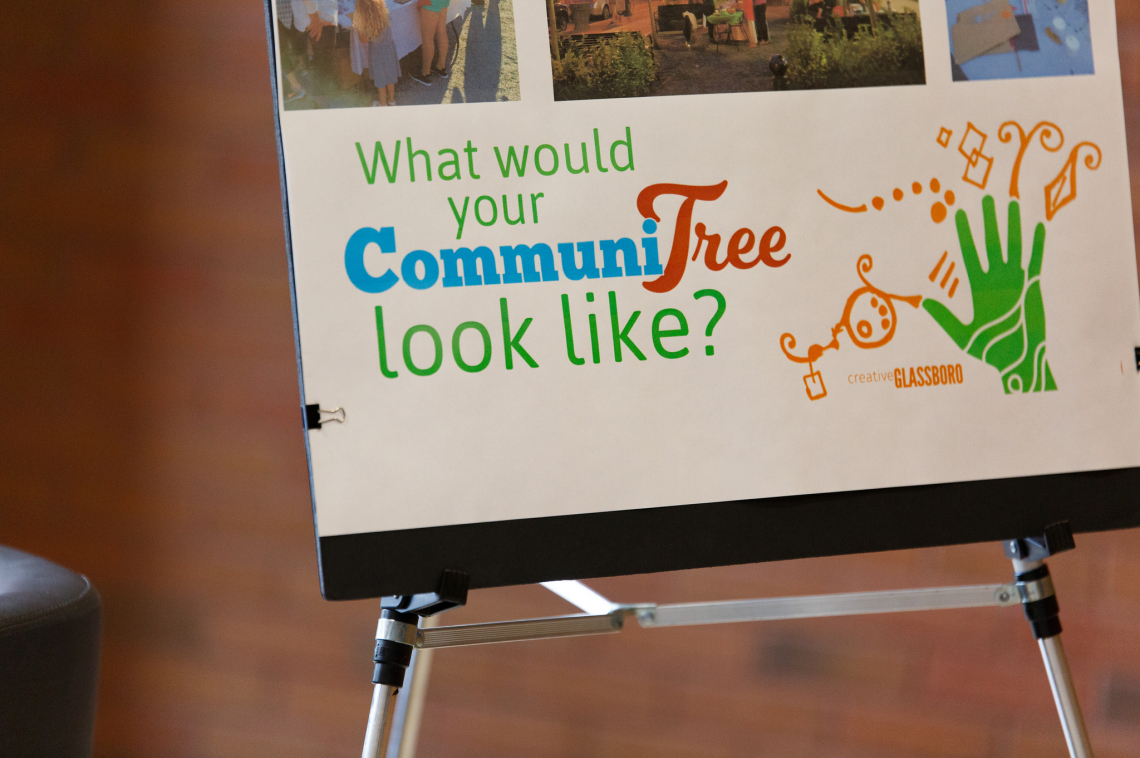

The session “On the Field: Finding Funding and Support” took place on May 3, 2018 at the Creative Placemaking Leadership Summit in Madison, New Jersey.
Before the experts discussed the issues and took questions from the audience, they invited participants to pick up a crayon and draw their personal experience of finding funding for a creative placemaking project.
No two sketches were alike, of course, but one elicited empathetic sounds from the crowd. It depicted a stick figure in a bed, money-related thought bubbles issuing from its head. According to its maker, it was “the universal representation of everybody who’s in this business: lying in bed—awake or dreaming—imagining how to raise the money to do this.”
Moderated by Margy Waller, Senior Fellow at Topos Partnership, this session convened a philanthropic funder, a municipal employee, and a community development leader, all of whom work on front lines of creative placemaking, to talk about finding funding and securing support. Waller spoke with Hope Knight, President & CEO of the Greater Jamaica Development Partnership in New York City; Sean Starowitz, Assistant Director for the Arts for the City of Bloomington, Indiana; and Leila Tamari, Senior Program Officer at ArtPlace America.
During their conversation and Q & A with the audience, a few themes emerged:
Nontraditional Funding is Possible & Powerful
Knight highlighted several creative placemaking projects in NYC that received support from unlikely sources. One was the ArtBridge project Step Up: Bronx In Motion, which was funded in part by NYC’s Department of Health & Mental Hygiene and Department of Transportation—not its Department of Cultural Affairs. “Some of the most exciting projects involve cobbling together different sources of funding,” Knight said.
Look for Unlikely Partnerships
Tamari said that when ArtPlace asked their grantees where their creative placemaking money came from, “foundation support” and “individual and board contributions” topped the list, but “in-kind contributions” was close on their heels, which suggested partnerships. “Maybe you didn’t think of what you were doing as a health project, for example, but your partner did,” she said.
Starowitz agreed. “Find a health partner to help you write that grant to the Robert Wood Johnson Foundation,” he said. “Look at library systems; look at universities. Code switch!”
Place-based Work is Key
Starowitz recalled the 1979 movie Breaking Away as “a good exploration of who owns places, and of art as civic infrastructure.” The film focuses on a group of working-class kids coming of age near the upper-class Indiana University Bloomington campus—a campus their parents, quarry miners, were instrumental in building, but then excluded from once their work was done.
Starowitz explained how his office had switched from an RFP (request for proposals) to an RFQ (request for qualifications) model for artists who want to make murals in Bloomington: “We ask, ‘Why do you want to work in this neighborhood? What’s your ability to communicate with residents here?’” he said. “We focus on vetting artists’ commitment to the process itself, and encourage them to work with local fabricators and landscape architects. These projects take social as well as financial capital to succeed.”
An audience member said her work was based in community stories, but was not necessarily site specific. “How can I look for grants that deal with community issues but also ‘fluid’ art?” she asked.
Tamari answered, “This work cannot happen if it’s not place-based. Even if you’re dealing with an issue like immigration that’s transient and moves across places, you can think about how people relate to each other about it in a specific place like a town or a neighborhood.”
Tamari gave a few other insights from her “30,000 feet up” view of grant-seeking. She explained two helpful frameworks are the Community Development Matrix and the four points of viable creative placemaking:
- What is the geographic community?
- What is the challenge, opportunity, or desired community change?
- What is the arts intervention that will address it?
- How will you know it’s working?
Crowdfunding can Demonstrate Buy-in as Well as Raise Revenue
Waller and Starowitz both mentioned Patronicity. Starowitz said his office had used the civic crowdfunding platform to help raise $100,000 for Bloomington’s Lotus World Music and Arts Festival.
Tamari said she wanted to shout out ioby, another such platform. She said running a crowdfunding campaign presents “a good chance for [creative placemaking practitioners] to get really clear on what they’re doing: ‘This is really about our main street,’ or ‘This is really about the environment in our town.” She added that crowdfunding can be a great place-based funding source when the work is occurring outside geographically based foundations’ purviews. “If people are working in Minnesota, the Bush Foundation might be a good option,” she said. “If they’re outside the range of philanthropies like those, crowdfunding can help.”
Knight said that in her experience, funders want to see community acceptance of a project—something a successful crowdfunding campaign can evidence.
Starowitz also spoke about leveraging such campaigns: “I can say, ‘We raised this much from our community. Can I get your foundation to match that?’ It helps everyone to see that mutual buy-in.”
Bite-sized Takeaways
- Starowitz recommended that even if you get state funding for a project, do not rely on the government to market it: invest in your own communications strategy and materials.
- When asked how best to present a project to funders that touches on multiple areas—in this case: theater, youth, and public safety—Tamari said, “Lead with your strength. Otherwise, your proposal will feel disingenuous. Funders can tell! At the same time, if you’re doing this work well, you’re working throughout the matrix. People don’t live in silos. It’s good to think more broadly.”
- An audience member from the Atlantic City Arts Foundation said that when she feels potential funders have a hard time grasping the concept of “the arts,” she finds “creativity” can go over better.
- Knight said that real estate developers, local businesses, and even banks can all be good sources of funding for creative placemaking initiatives.
- Tamari stressed the importance of starting small and piloting new ideas. “Especially if you’re new to your community—an ‘outsider’—working this way will help you avoid problems, and get clearer about your purpose.”
- An audience member from the South Jersey Cultural Alliance said her organization was experimenting with using arts competitions to attract corporate sponsorship.
- When asked about securing sustained support for rural projects, Starowitz said, “Rural dynamics are very tricky. We need to hold our representatives liable. Show up to city and county council; ask for a meeting with your county commissioner. Hold their feet to the fire.”
April Greene is an established freelance writer and editor. To learn more about April please visit: aprilgreene.com.





